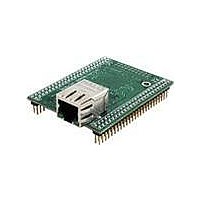MOD5234-100IR NetBurner Inc, MOD5234-100IR Datasheet - Page 369

MOD5234-100IR
Manufacturer Part Number
MOD5234-100IR
Description
MOD5234 10/100 ETHERNET MODULE
Manufacturer
NetBurner Inc
Type
Controllers & Processorsr
Datasheets
1.MOD5272-100IR.pdf
(3 pages)
2.MOD5234-100IR.pdf
(4 pages)
3.MOD5234-100IR.pdf
(754 pages)
Specifications of MOD5234-100IR
Interface
I²C, SPI, UART
Voltage - Supply
2.5V
Mounting Type
Surface Mount
Package / Case
Module
Product
Modules
Lead Free Status / RoHS Status
Lead free / RoHS Compliant
Data Format
-
Baud Rates
-
Lead Free Status / Rohs Status
Lead free / RoHS Compliant
Other names
Q4483564
- Current page: 369 of 754
- Download datasheet (13Mb)
Memory Map/Register Definition
software via the serial management interface (EMDC/EMDIO pins) to the transceiver. Refer to the
MMFR and MSCR register descriptions as well as the section on the MII for a description of how
to read and write registers in the transceiver via this interface.
19.1.5.2 10 Mpbs 7-Wire Interface Operation
The FEC supports a 7-wire interface as used by many 10 Mbps ethernet transceivers. The
RCR[MII_MODE] bit controls this functionality. If this bit is cleared, the MII mode is disabled
and the 10 Mbps, 7-wire mode is enabled.
19.1.6 Address Recognition Options
The address options supported are promiscuous, broadcast reject, individual address (hash or exact
match), and multicast hash match. Address recognition options are discussed in detail in
Section 19.3.8, “Ethernet Address
Recognition.”
19.1.7 Internal Loopback
Internal loopback mode is selected via RCR[LOOP]. Loopback mode is discussed in detail in
Section 19.3.13, “ Internal and External
Loopback.”
19.2
Memory Map/Register Definition
This section gives an overview of the registers, followed by a description of the buffers.
The FEC is programmed by a combination of control/status registers (CSRs) and buffer
descriptors. The CSRs are used for mode control and to extract global status information. The
descriptors are used to pass data buffers and related buffer information between the hardware and
software.
19.2.1 High-Level Module Memory Map
The FEC implementation requires a 1-Kbyte memory map space. This is divided into 2 sections
of 512 bytes each. The first is used for control/status registers. The second contains event/statistic
counters held in the MIB block.
Table 19-1
defines the top level memory map.
Table 19-1. Module Memory Map
Address
Function
IPSBAR + 0x1000–11FF
Control/Status Registers
IPSBAR + 0x1200–13FF
MIB Block Counters
MCF5235 Reference Manual, Rev. 2
Freescale Semiconductor
19-5
Related parts for MOD5234-100IR
Image
Part Number
Description
Manufacturer
Datasheet
Request
R

Part Number:
Description:
MCU, MPU & DSP Development Tools MOD5234 MODULE
Manufacturer:
NetBurner Inc
Datasheet:

Part Number:
Description:
MCU, MPU & DSP Development Tools MOD5234 Core Module Development Kit
Manufacturer:
NetBurner Inc
Datasheet:

Part Number:
Description:
BOARD SERIAL-ETHERNET 512K FLASH
Manufacturer:
NetBurner Inc
Datasheet:

Part Number:
Description:
PROCESSOR MODULE FLASH MOD5272
Manufacturer:
NetBurner Inc
Datasheet:

Part Number:
Description:
PROCESSOR MODULE 512KB FLASH
Manufacturer:
NetBurner Inc
Datasheet:

Part Number:
Description:
DUAL PORT SERIAL-ETHERNET
Manufacturer:
NetBurner Inc
Datasheet:

Part Number:
Description:
PROCESSOR MODULE FLASH
Manufacturer:
NetBurner Inc
Datasheet:

Part Number:
Description:
PROCESSOR MODULE 512KB FLASH
Manufacturer:
NetBurner Inc
Datasheet:

Part Number:
Description:
KIT DEVELOP NETWORK FOR MOD5282
Manufacturer:
NetBurner Inc
Datasheet:

Part Number:
Description:
KIT DEVELOP NETWORK FOR MOD5272
Manufacturer:
NetBurner Inc
Datasheet:

Part Number:
Description:
DUAL PORT SERIAL-ETHERNET
Manufacturer:
NetBurner Inc
Datasheet:

Part Number:
Description:
Ethernet Modules & Development Tools 32 Bit 66MHz 40 Pin DIP Industrial Temp
Manufacturer:
NetBurner Inc
Datasheet:

Part Number:
Description:
Ethernet ICs 32bit 147MHz CAN-to- Ethnt Device IndTemp
Manufacturer:
NetBurner Inc
Datasheet:










